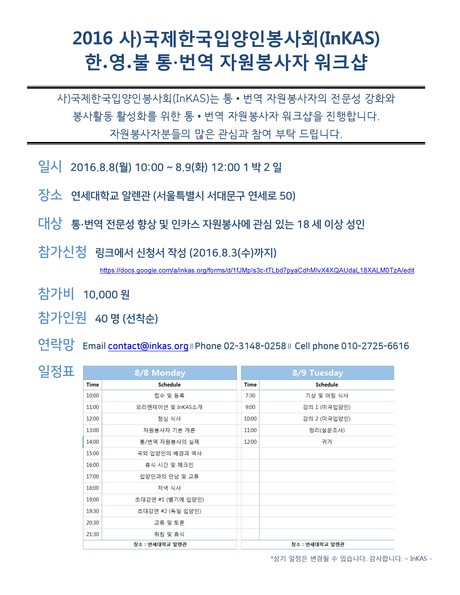8/30 (화) 낮 12시쯤부터 8/31(수) 낮 12시까지 목포에서 영어 통역을 도와주실 봉사자 분을 찾습니다.
한국에 방문하여 목포에 계시는 친아버지를 뵙는 남성 입양인분을 도와드리는 봉사입니다.
봉사 가능하신 분들은 '댓글' 부탁드리겠습니다.
감사합니다.
Add/Remove email notification | RSS Feed
Written by on date 2016-08-29 in Ask Volunteer .
8/30 (화) 낮 12시쯤부터 8/31(수) 낮 12시까지 목포에서 영어 통역을 도와주실 봉사자 분을 찾습니다.
한국에 방문하여 목포에 계시는 친아버지를 뵙는 남성 입양인분을 도와드리는 봉사입니다.
봉사 가능하신 분들은 '댓글' 부탁드리겠습니다.
감사합니다.
Written by on date 2016-08-26 in Ask Volunteer .
9/2(금) 한국을 방문하는 입양인가족의 서울 가이드를 도와주실 봉사자분을 찾습니다.
한국을 처음 방문하시는 덴마크 입양인(여성)분과 그의 가족의 서울 방문을 도와드리는 봉사입니다.
첫 방문이시고, 한국어도 잘 못하시기때문에 살뜰히 도와드릴 수 있는 봉사자분의 도움을 기다립니다.
봉사 가능하신 분은 '댓글' 부탁드려요.
오늘도 힘나는 하루 보내세요, 감사합니다!
Written by on date 2016-08-24 in Ask Volunteer .
입양인분이 쓰신 영어 편지를 한국어로 번역하는 봉사입니다.
분량은 A4 반 장정도입니다.
봉사 가능하신 봉사자분의 댓글을 기다립니다.
오늘도 힘나는 하루 보내세요, 감사합니다!
Written by on date 2016-08-03 in Ask Volunteer .
귀화증명서 한국어로 번역해 주실 봉사자 연락 주십시오.
A4용지 1페이지 분량입니다. 감사합니다.
Written by on date 2016-08-03 in Ask Volunteer .
입양인과 한국 가족 만남 시 통역을 도와드릴 봉사자분을 찾고 있습니다.
8/6(토) 영어 통역 가능하신 봉사자분의 댓글 부탁드립니다.
자세한 일정은 연결된 후에 알려드릴게요.
좋은 하루 보내세요, 감사합니다. :)
Written by on date 2016-08-03 in Ask Volunteer .
미국 입양인이 가족과 만남시 통역을 도와 줄 봉사자분을 찾습니다.
- 8/5(금) : 서울 및 산본 일정 소화 예정
- 8/6(토) : 출국(pm 3:00), 오전 일정 후 공항까지 함께 갈 예정
자세한 일정은 봉사자분 연결 후에 알려드리겠습니다.
8/5(금) 또는 8/6(토) 중 가능하신 날짜에 댓글 남겨주시면 감사하겠습니다.
좋은 하루 보내세요. :)
Written by on date 2016-08-02 in Ask Volunteer .
서대문보건소에서 정기검진 진행하는 미국 입양여성의 통역 도와 주실 봉사자 찾습니다.
소변검사, 피검사, X-RAY등 기본검사 진행 예정입니다.
만나는장소: 서대문보건소(02:330-8957, 8953서대문구 연희로 242)
만나는시간: 8/10(수) 오전 10시 30분
혹, 다른요일 시간 가능하신분은 요일명기 댓글 주시면 조정해 보겠습니다. 감사합니다.
2016 사)국제한국입양인봉사회(InKAS)는 통/번역 자원봉사자의 전문성 강화와 봉사활동 활성화를 위한 통/번역 자원봉사자 워크샵을 진행합니다.
자원봉사자분들의 많은 관심과 참여 부탁드립니다.
참가신청은 아래 링크에서 가능합니다.
https://docs.google.com/a/inkas.org/forms/d/1fJMpIs3c-tTLbd7pyaCdhMIvX4XQAUdaL18XALM0TzA/edit


Written by on date 2016-07-29 in Ask Volunteer .
경희대에서 한국어를 배우고 있는 네델란드 입양여성에게 한국어 가르쳐주실 봉사자 찾습니다.
의뢰인이 회화 연습을 많이하길 원합니다. 주중 오후시간에 시간여유 있는분의 댓글 기다립니다.
만날 장소는 회기동 근처이나 좀 떨어진 지역이라도 괜찮다고 합니다. 주 1회 만나 2시간 정도씩 지도해 주면 됩니다.
감사합니다.
Written by on date 2016-07-26 in Ask Volunteer .
덴마크 입양여성에게 한국어 가르쳐 주실 봉사자 찾습니다.
주 1회 2시간 가량 지도해 주면됩니다. 주중 오후 시간이나 주말이 좋다고 합니다.
가능한시간과 요일을 명시하여 댓글 보내 주십시오. 만날 장소는 신촌의 이화여대 부근입니다.
감사합니다.